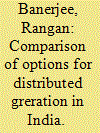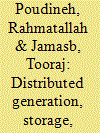|
|
|
Sort Order |
|
|
|
Items / Page
|
|
|
|
|
|
|
| Srl | Item |
| 1 |
ID:
068414


|
|
|
| 2 |
ID:
126552


|
|
|
|
|
| Publication |
2013.
|
| Summary/Abstract |
Energy resources for rural electrification are variable and widely dispersed, such that a solution for one region might not be appropriate for another. This study evaluates the feasibility of renewable energy technologies, centralized grid extension and local coal-fired power for rural areas that currently do not have sufficient access to electricity. The renewable power generation options considered are solar photovoltaic and wind power, with battery storage or fossil fuel generator backup. New local coal-fired power, as well as extension of the grid from an existing centralized power system, are considered to compare the impacts of scale and traditional approaches to power generation. A case study for a rural area in Northwestern China demonstrates the complexity of energy decision-making when faced with low peak demands and non-ideal renewable resource availability. Economic factors, including cost of electricity generation, breakeven grid extension distance, capacity shortage fraction (the ratio of the annual capacity shortage to the annual electric load) and land use are evaluated.
|
|
|
|
|
|
|
|
|
|
|
|
|
|
|
|
| 3 |
ID:
109443


|
|
|
|
|
| Publication |
2011.
|
| Summary/Abstract |
The unbundling of the electricity power system will play a key role on the deployment of distributed generation (DG) in European distribution systems evolving towards Smart Grids. The present paper firstly reviews the relevant European Union (EU) regulatory framework: specific attention is paid to the concept of unbundling of power distribution sector in Europe. Afterwards, the focus is on the current state of penetration of DG technologies in the EU Member States and the corresponding interrelations with distribution features. A comparison between the unbundling of the distribution and supply markets using econometric indicators such as the Herfindahl-Hirschmann (IHH) and the Shannon-Wiener (ISW) indices is then presented. Finally, a comparative analysis between these indices and the current level of penetration of distributed generation in most EU is shown; policy recommendations conclude the paper.
|
|
|
|
|
|
|
|
|
|
|
|
|
|
|
|
| 4 |
ID:
128352


|
|
|
|
|
| Publication |
2014.
|
| Summary/Abstract |
The need for investment in capital intensive electricity networks is on the rise in many countries. A major advantage of distributed resources is their potential for deferring investments in distribution network capacity. However, utilizing the full benefits of these resources requires addressing several technical, economic and regulatory challenges. A significant barrier pertains to the lack of an efficient market mechanism that enables this concept and also is consistent with business model of distribution companies under an unbundled power sector paradigm. This paper proposes a market-oriented approach termed as "contract for deferral scheme" (CDS). The scheme outlines how an economically efficient portfolio of distributed generation, storage, demand response and energy efficiency can be integrated as network resources to reduce the need for grid capacity and defer demand driven network investments.
|
|
|
|
|
|
|
|
|
|
|
|
|
|
|
|
| 5 |
ID:
094240


|
|
|
|
|
| Publication |
2010.
|
| Summary/Abstract |
The purpose of this paper is to examine the lessons from the recent history of telecoms deregulation for electricity (and by implication heat) network regulation. We do this in the context of Ofgem's RPI-X@20 Review of energy regulation in the UK, which considers whether RPI-X-based price regulation is fit for purpose after over 20 years of operation in energy networks. We examine the deregulation of fixed line telecoms in the UK and the lessons which it seems to suggest. We then apply the lessons to electricity networks in the context of a possible increase in distributed generation directly connected to local distribution networks. We conclude that there is the possibility of more parallels over time and suggest several implications of this for the regulation of electricity and heat networks.
|
|
|
|
|
|
|
|
|
|
|
|
|
|
|
|
| 6 |
ID:
136234


|
|
|
|
|
| Summary/Abstract |
Net-metering is commonly known as a practice by which owners of distributed generation (DG) units may offset their electricity consumption from the grid with local generation. The increasing number of prosumers (consumers that both produce and consume electricity) with solar photovoltaic (PV) generation combined with net-metering results in reduced incomes for many network utilities worldwide. Consequently, this pushes utilities to increase charges per kW h in order to recover costs. For non-PV owners, this could result into inequality issues due to the fact that also non-PV owners have to pay higher chargers for their electricity consumed to make up for netted costs of PV-owners. In order to provide insight in those inequality issues caused by net-metering, this study presents the effects on cross-subsidies, cost recovery and policy objectives evolving from different applied netmetering and tariff designs for a residential consumer. Eventually this paper provides recommendations regarding tariffs and metering that will result in more explicit incentives for PV, instead of the current implicit incentives which are present to PV owners due to net-metering.
|
|
|
|
|
|
|
|
|
|
|
|
|
|
|
|
| 7 |
ID:
090100


|
|
|
|
|
| Publication |
2009.
|
| Summary/Abstract |
Distributed generation units are desirable from an environmental point of view but also have an impact on the costs of electricity grids at the distribution and transmission level. Therefore, investment planning has to consider all benefits and costs of DG to build DG sources at sites where they are economically efficient. Unfortunately, this is not an easy task in an unbundled industry where distribution and generation of electricity are not planned by one single institution. For this reason, this article analyses possible policy options for giving incentives to distributed generation and focuses on the long-term investment signals related to DG.
|
|
|
|
|
|
|
|
|
|
|
|
|
|
|
|
| 8 |
ID:
052294


|
|
|
|
|
| Publication |
Oct 2004.
|
| Summary/Abstract |
The purpose of this paper is to weigh the issues and options for increasing electricity access in remote and geographically challenged villages in interior Rajasthan, the desertstate in Western India where power sector reforms are currently underway. By first providing an overview of reforms and various electrification policy initiatives in India, the paper then analyzes the specific problems as studied at the grass-roots level with respect to rural electricity access and the use of off-grid renewables. Finally, it discusses interventions that could facilitate access to electricity by suggesting a sequential distributed generation (DG)-based approach, wherein consecutive DG schemes-incorporating the requisite technological, financial, and institutional arrangements-are designed depending on the developmental requirements of the community. In essence, this approach fits under the broader need to understand how the three "Rs"- rural electrification (the process), power sector reforms (the catalyst), and the use of renewable energy technologies (the means)-could potentially converge to meet the needs of India's rural poor.
|
|
|
|
|
|
|
|
|
|
|
|
|
|
|
|
| 9 |
ID:
117333


|
|
|
|
|
| Publication |
2013.
|
| Summary/Abstract |
Anaerobic digestion is increasingly recognized for its ability to produce renewable energy and reduce greenhouse gas emissions from livestock operations. In 2010, there were 2645 U.S. dairy farms with herd sizes large enough to support anaerobic digesters, yet only 156 systems were in operation (U.S. Environmental Protection Agency (U.S. EPA), 2010a. Market Opportunities for Biogas Recovery Systems at U.S. Livestock Facilities. AgSTAR Program; U.S. Environmental Protection Agency (U.S. EPA), 2011. Operational Anaerobic Digesters, Sorted by State (Dairy). AgSTAR Program.).1 This study analyzes the net present value of digester systems under alternative electricity purchase agreements and how returns are affected by standby charges, net metering policies and the use of feed-in-tariffs. In order for digester potential to be fully realized on a state or national level, changes to distributed energy policy are required. Results indicated that standby charges can reduce revenues from offsetting electricity by an average of nearly 20%. Net metering rules limit participation among larger farms and negatively affect profitability by restricting engine-generator size. Lastly, the effectiveness of a fixed price feed-in-tariff policy for digesters is significantly affected by project size differentiation. Digester energy policies are similar nationwide, making this study useful for government regulatory agencies and digester owners throughout the U.S.
|
|
|
|
|
|
|
|
|
|
|
|
|
|
|
|
| 10 |
ID:
150754


|
|
|
|
|
| Summary/Abstract |
High demand for photovoltaic (PV), battery, and small-scale combined heat and power (CHP) technologies are driving a virtuous cycle of technological improvements and cost reductions in off-grid electric systems that increasingly compete with the grid market. Using a case study in the Upper Peninsula of Michigan, this paper quantifies the economic viability of off-grid PV+battery+CHP adoption and evaluates potential implications for grid-based utility models. The analysis shows that already some households could save money by switching to a solar hybrid off-grid system in comparison to the effective electric rates they are currently paying. Across the region by 2020, 92% of seasonal households and ~75% of year-round households are projected to meet electricity demands with lower costs. Furthermore, ~65% of all Upper Peninsula single-family owner-occupied households will both meet grid parity and be able to afford the systems by 2020. The results imply that economic circumstances could spur a positive feedback loop whereby grid electricity prices continue to rise and increasing numbers of customers choose alternatives (sometimes referred to as a “utility death spiral”), particularly in areas with relatively high electric utility rates. Utility companies and policy makers must take the potential for grid defection seriously when evaluating energy supply strategies.
|
|
|
|
|
|
|
|
|
|
|
|
|
|
|
|
| 11 |
ID:
192758


|
|
|
|
|
| Summary/Abstract |
Starting from the EU vision for Energy Communities (EC), our purpose is to support them by proposing a Digital Twin (DT) that includes a bi-level optimization model to deliver coordination, economic, social, and environmental benefits to its members that can be quantified as Key Performance Indicators (KPI). The diversity of EC members from the size and interest perspectives leads us to consider a bi-level optimization model. It offers support to individual consumers/prosumers (first level) and coordination for EC (second level). This model is embedded into a DT that replicates the EC and the operation of individual entities such as consumers/prosumers and public assets. The DT is created as an automatic assistant with two components: iEMS – as a member's assistant and eEMS – as an EC assistant. These components optimize the schedule, generate bids for the Local Electricity Market (LEM) and control the flexible appliances of the participants to deal with deficits and surpluses. The DT receives input from EC members, LEM, metering system and improves the operation of the EC in a two-way continuous exchange data flow. Furthermore, it is a reliable framework to test and improve models, regulations and policies in emergent EC as DT provides alternatives regarding its functionalities: optimization, market operation, setting the clearing price, settlement, value sharing for distributing benefits, etc. It can be extended to support grid operators to design tariffs, testing regulation and offer additional energy services. The proposed DT model is tested within an EC case study, both on a seasonal and an annual basis. The average trading index on LEM is 0.6 during the summer and 0.3 during the winter months, while the Degree of Local Sufficiency (DLS) for the EC is 0.45 in summer and 0.28 in winter. Moreover, the proposed LFM model reduces the exchanges with the main grid by an average of 45 kW in summer, that represents almost 15% of the average exchange at peak hours.
|
|
|
|
|
|
|
|
|
|
|
|
|
|
|
|
| 12 |
ID:
149873


|
|
|
|
|
| Summary/Abstract |
The transition from fossil fuels to renewable resources is highly desirable to reduce air pollution, and improve energy efficiency and security. Many observers are concerned, however, that the diffusion of systems based on renewable resources may give rise to energy sprawl, i.e. an increasing occupation of available land to build new energy facilities of this kind. These critics foresee a transition from the traditional fossil-fuel systems, towards a renewable resource system likewise based on large power stations and extensive energy grids. A different approach can be taken to reduce the risk of energy sprawl, and this will happen if the focus is as much on renewable sources as on the introduction of distributed renewable energy systems based on micro plants (photovoltaic panels on the roofs of buildings, micro wind turbines, etc.) and on multiple micro-grids. Policy makers could foster local energy enterprises by: introducing new enabling rules; making more room for contractual communities; simplifying the compliance process; proposing monetary incentives and tax cuts. We conclude that the diffusion of innovation in this field will lead not to an energy sprawl but to a new energy system characterized by a multi-layered density: a combination of technology, organization, and physical development.
|
|
|
|
|
|
|
|
|
|
|
|
|
|
|
|
| 13 |
ID:
176769


|
|
|
|
|
| Summary/Abstract |
The United States (U.S.) electric power sector historically comprises the largest portion of greenhouse gas (GHG) emissions from the world's second-largest GHG emitter. Consequently, carbon accounting methods employed for this economic sector play an important role in ensuring the accuracy of carbon accounts globally. For the U.S., the diverse purposes and methods of eight federal data products yield eight different estimates of U.S. electric-sector carbon dioxide emissions. Prior studies neither fully characterized these differences nor evaluated the data products' ability to capture changes in carbon dioxide emissions from certain now-minor sources of electricity that are projected to increase as the grid modernizes. Here we explore how shifts in electricity sources might impact current carbon accounting methods. We show that if no changes are made, four of the six data products could exclude (via omission or attribution) 1.1%–3.3% of carbon dioxide emissions from U.S. electricity generation in 2040. Maintaining comprehensive tracking of electric-sector emissions through the suggestions made herein can help enable efficient allocation of mitigation resources
|
|
|
|
|
|
|
|
|
|
|
|
|
|
|
|
| 14 |
ID:
125713


|
|
|
|
|
| Publication |
2013.
|
| Summary/Abstract |
Planning of national energy policies brings new dilemmas with the introduction of distributed generators (DG). Economic theory suggests that a perfectly competitive market would lead to efficient pricing. In the absence of competition, regulators play a fundamental role in attracting reasonably priced finance in order to maintain, refurbish and increase the infrastructure and provide services at a reasonable cost. Energy market price equilibrium is mainly dependent on suppliers, generators, energy sources and demand, represented by conventional utility grid users. Its behavior is similar to that of other commodities. As generation becomes less centralized with the increasing economic viability of renewable energy sources, new suppliers are being connected to the grid. Such evolution means the transition from a monopolistic market to a broader and more open environment, with an increasing number of competitors. We make use of variational inequalities to model a hypothetical DG market in different scenarios, from monopoly, to oligopoly, to open market. Such an approach enables different equilibrium outcomes due to different DG penetration levels. Based on these findings, we argue that energy policies for such markets must be developed according to each specific stage of the grid's lifecycle. We show how energy policies and market regulations may affect such a transition, which may be catastrophic if not managed properly, and which is dependent on the energy mix.
|
|
|
|
|
|
|
|
|
|
|
|
|
|
|
|
| 15 |
ID:
186412


|
|
|
|
|
| Summary/Abstract |
Distributed energy resources (DERs) are poised to play a significant role in evolving power systems because of their flexibility to be sited in areas of high value to the grid. Traditional DER compensation frameworks, specifically net energy metering (NEM), inadequately communicate differences in the locational and temporal value of DER generation to the grid. As a transition from NEM, New York State's (NYS's) Value of Distributed Energy Resources (VDER) framework provides a methodology for calculating different value components that DERs offer the grid. To study the impacts of VDER frameworks on DER deployment, we developed a model to assess the value of distributed solar and wind systems configured as either a behind-the-meter system or a front-of-the-meter system for each parcel of land in NYS. Using parcel-level granularity, we can closely evaluate DER locational value and siting availability, particularly in urban and suburban settings. Our analysis finds while most DER generators would be modestly compensated for deferred transmission and distribution infrastructure upgrades (~0.01 $/kWh for solar PV), a subset of projects receive significant value from this component (0.035 to 0.089 $/kWh for top 5% of parcels for solar PV). Finally, our analysis finds VDER provides less overall compensation than NEM to the average DER generator, however, it increases access to compensation for front-of-the-meter DERs – a large and emerging market.
|
|
|
|
|
|
|
|
|
|
|
|
|
|
|
|
| 16 |
ID:
109665


|
|
|
|
|
| Publication |
2011.
|
| Summary/Abstract |
Distributed generation is being deployed at increasing levels of penetration on electricity grids worldwide. It can have positive impacts on the network, but also negative impacts if integration is not properly managed. This is especially true of photovoltaics, in part because it's output fluctuates significantly and in part because it is being rapidly deployed in many countries. Potential positive impacts on grid operation can include reduced network flows and hence reduced losses and voltage drops. Potential negative impacts at high penetrations include voltage fluctuations, voltage rise and reverse power flow, power fluctuations, power factor changes, frequency regulation and harmonics, unintentional islanding, fault currents and grounding issues. This paper firstly reviews each of these impacts in detail, along with the current technical approaches available to address them. The second section of this paper discusses key non-technical factors, such as appropriate policies and institutional frameworks, which are essential to effectively coordinate the development and deployment of the different technical solutions most appropriate for particular jurisdictions. These frameworks will be different for different jurisdictions, and so no single approach will be appropriate worldwide.
|
|
|
|
|
|
|
|
|
|
|
|
|
|
|
|
| 17 |
ID:
166949


|
|
|
|
|
| Summary/Abstract |
The recent rise of distributed generation and self-consumption, together with the unbundling of the electricity supply chain, sprout the opportunity for innovative energy policies that increasingly place end-users as active agents of the system and democratize access to the energy markets. Such is the case of the emerging concepts of virtual metering, peer-to-peer energy trading, shared generation and local network charges, hereby grouped under the umbrella policy genre “Prosumer Aggregation Policies”. This paper sets out to describe the fundamental mechanisms within these concepts, to categorize them and their policy impacts, in order to guide regulators, decision-makers and the research community through the key steps and considerations involved in the design of Prosumer Aggregation Policies. Based on a comprehensive assessment of country experiences and a showcase of real business models and pilot projects, it is argued that prosumer aggregation policies significantly enhance prosumers’ drivers and improve the potential market of distributed generation and traditional self-consumption policies, ultimately providing policy access to all end-users regardless of possessing the appropriate site or resource conditions. They also address challenges for grid operators regarding grid integration and market integration of distributed generation, helping to minimize their impact in grid management.
|
|
|
|
|
|
|
|
|
|
|
|
|
|
|
|
| 18 |
ID:
109353


|
|
|
|
|
| Publication |
2011.
|
| Summary/Abstract |
This paper examines the air quality impact of using distributed generation (DG) to satisfy future growth in power demand in the South Coast Air Basin of Los Angeles, relative to the impact when the demand is met by expanding current central generation (CG) capacity. The impact of decreasing boiler emissions by capturing the waste heat from DGs is not examined. The air quality impacts of these two alternate scenarios are quantified in terms of hourly maximum ground-level and annually averaged primary NOx concentrations, which are estimated using AERMOD. This study focuses on the impact of primary emissions at source-receptor distances of tens of kilometers. We find that the shift to DGs has the potential for decreasing maximum hourly impacts of power generation in the vicinity of the DGs. The maximum hourly concentration is reduced from 25 to 6 ppb if DGs rather than CGs are used to generate power. However, the annually averaged concentrations are likely to be higher than for the scenario in which existing CGs are used to satisfy power demand growth. Future DG penetration will add an annual average of 0.1 ppb to the current basin average, 20 ppb, while expanding existing CGs will add 0.05 ppb.
|
|
|
|
|
|
|
|
|
|
|
|
|
|
|
|
| 19 |
ID:
150710


|
|
|
|
|
| Summary/Abstract |
This paper examines the question of how to incentivize the adoption and use of renewable energy resources, with particular attention on distributed renewable energy (DRE). Prior experience suggests that price and quantity-based programs, such as feed-in tariffs, provide more efficient renewable adoption and use and lower program costs than programs that set quantity targets only. We also examine some cost-allocation issues raised by the use of DRE systems and fixed time-invariant retail pricing. This combination can result in customers with DRE systems paying a disproportionately small portion of system capacity costs. We suggest two retail-pricing schemes, real-time pricing and a two-part tariff with demand charges, to address these issues.
|
|
|
|
|
|
|
|
|
|
|
|
|
|
|
|
| 20 |
ID:
166350


|
|
|
|
|
| Summary/Abstract |
This paper studies the decision to synchronize household electricity consumption and production. While this behavior is beneficial for the energy system as a whole, it is not encouraged by a net-metering system. Relying on a large-scale survey conducted among households with solar PV in Wallonia, we investigate the factors impacting their decision to self-consume. As many as forty percent of our respondents declare to do so, notwithstanding the lack of incentives. The multivariate regression analysis shows that female and older residents, who tend to spend more time at home during daytime, are more likely to adapt their electricity usage by displacing their load. Prosumers with high environmental motives tend to synchronize more no matter the size of their installation. We conclude that prosumers will be further encouraged to self-consume by (1) setting monetary incentives to make consumption at the time of production more attractive, by (2) providing information to prosumers relative to their consumption/production profile and (3) by encouraging the adoption of smart devices that facilitate load shifting. These policies would lead to a higher degree of synchronization that would be beneficial for the energy system.
|
|
|
|
|
|
|
|
|
|
|
|
|
|
|
|
|
|
|
|
|